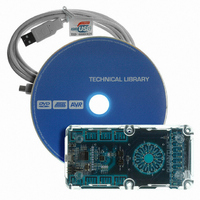ATAVRTS2080B Atmel, ATAVRTS2080B Datasheet - Page 128

ATAVRTS2080B
Manufacturer Part Number
ATAVRTS2080B
Description
BOARD EVAL FOR ATTINY88 LIBRARY
Manufacturer
Atmel
Series
QTouch™r
Specifications of ATAVRTS2080B
Sensor Type
Touch, Capacitive
Sensing Range
1 Rotor, 1 Slider, and 2 Buttons/Keys
Interface
Application Programming Interface (API)
Voltage - Supply
1.8 V ~ 5.5 V
Embedded
Yes, MCU, 8-Bit
Utilized Ic / Part
ATtiny88
Tool Type
Development Kit
Cpu Core
AVR 8 / 32
Data Bus Width
8 bit
Core Architecture
AVR
Silicon Manufacturer
Atmel
Silicon Core Number
ATtiny88
Silicon Family Name
AVR
Kit Contents
Board CD Docs
Development Tool Type
Hardware / Software - Eval/Demo Board
Rohs Compliant
Yes
Lead Free Status / RoHS Status
Lead free / RoHS Compliant
Sensitivity
-
Lead Free Status / Rohs Status
Details
Other names
Q4359953
- Current page: 128 of 178
- Download datasheet (4Mb)
\Device_Specific_Libraries\32bit_AVR\UC3L\example_projects\uc3l_gnu_qm_ek_example and
\Device_Specific_Libraries\32bit_AVR\UC3L\example_projects\uc3l_iar_qm_ek_example
The QMatrix Example projects demonstrate the QMatrix operation on the UC3L Evaluation Kit
(Rev 2). QMatrix SMP discharge mode hardware arrangement is used for the UC3L Evaluation
Kit with 6 X Lines and 2 Y Lines. Using the 12 Touch Channels (6x2), 6 Touch Sensors are
formed that include a Rotor (that uses six Touch Channels) and 5 keys (each using one Touch
channel).
The Example projects demonstrate the QMatrix measured data and Touch Status usage using
the LED Demo application. The onboard LED0, LED1, LED2 and LED3 are set when the Touch
Position of the Rotor position varies from 0 to 255. By Touching the up key (^), left key (<),
play/pause key (>/||) and right key (>), the LED0, LED1, LED2 and LED3 can be individually
cleared. When the down key (v) is touched, it clears all LEDs.
6.3.12.3 QTouch Group A Example Project
The QTouch Group A method GNU and IAR Example projects can be found in the following path.
\Device_Specific_Libraries\32bit_AVR\UC3L\example_projects\uc3l_gnu_qt_grp_a_example and
\Device_Specific_Libraries\32bit_AVR\UC3L\example_projects\uc3l_iar_qt_grp_a_example
The QTouch Group A Example projects demonstrate the QTouch method API usage with a
Rotor, Slider and two keys Sensor configuration.
6.3.12.4 Autonomous QTouch Example Project
The Autonomous QTouch Sensor GNU and IAR Example projects can be found in the following
path.
\Device_Specific_Libraries\32bit_AVR\UC3L\example_projects\
uc3l_gnu_autonomous_qt_example and
\Device_Specific_Libraries\32bit_AVR\UC3L\example_projects\
uc3l_iar_autonomous_qt_example
The Autonomous QTouch Example projects demonstrate the Autonomous QTouch Sensor API
usage.
Asynchronous Timer peripheral event.
Note 1: The Example Projects also support relaying the Touch Sensor debug information to the
“QTouch Studio – Touch Analyzer” PC Software. The QTouch Studio can also be used for
setting the Sensor and Global configuration parameters of the QTouch Library at run-time.
The QTouch Studio can be downloaded from the following path.
http://www.atmel.com/products/touchsoftware/qtouchsuite.asp?family_id=702
The QDebug two-way debug protocol used by the Example project to communicate (transmit or
receive touch debug data) with the QTouch Studio can be found in the following installation path.
\Device_Specific_Libraries\32bit_AVR\UC3L\qdebug
128
•
For the UC3L Evaluation kit (uc3l_xx_qm_ek_example Example project) to connect with
the QTouch Studio using the USB interface, the UC3B MCU on the UC3L Evaluation kit
must be Flashed with ISP and Program binaries. The procedure to flash the binaries is
available in the readme note in the following path.
\Device_Specific_Libraries\32bit_AVR\UC3L\example_projects\uc3l_gnu_qm_ek_exampl
e\ uc3b\readme.txt or
The Example projects also demonstrate wake up from Sleep mode using the
8207J-AT42-02/11
Related parts for ATAVRTS2080B
Image
Part Number
Description
Manufacturer
Datasheet
Request
R

Part Number:
Description:
DEV KIT FOR AVR/AVR32
Manufacturer:
Atmel
Datasheet:

Part Number:
Description:
INTERVAL AND WIPE/WASH WIPER CONTROL IC WITH DELAY
Manufacturer:
ATMEL Corporation
Datasheet:

Part Number:
Description:
Low-Voltage Voice-Switched IC for Hands-Free Operation
Manufacturer:
ATMEL Corporation
Datasheet:

Part Number:
Description:
MONOLITHIC INTEGRATED FEATUREPHONE CIRCUIT
Manufacturer:
ATMEL Corporation
Datasheet:

Part Number:
Description:
AM-FM Receiver IC U4255BM-M
Manufacturer:
ATMEL Corporation
Datasheet:

Part Number:
Description:
Monolithic Integrated Feature Phone Circuit
Manufacturer:
ATMEL Corporation
Datasheet:

Part Number:
Description:
Multistandard Video-IF and Quasi Parallel Sound Processing
Manufacturer:
ATMEL Corporation
Datasheet:

Part Number:
Description:
High-performance EE PLD
Manufacturer:
ATMEL Corporation
Datasheet:

Part Number:
Description:
8-bit Flash Microcontroller
Manufacturer:
ATMEL Corporation
Datasheet:

Part Number:
Description:
2-Wire Serial EEPROM
Manufacturer:
ATMEL Corporation
Datasheet:












